Validating the role of inhibitory interneurons in memory (Neuron, 2023)
Newly developed labeling method allows for visualization of intraregional synaptic connections between inhibitory interneurons and excitatory engram cells
more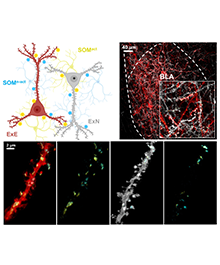
Newly developed labeling method allows for visualization of intraregional synaptic connections between inhibitory interneurons and excitatory engram cells
more
Through joint research with the Neuroscience Research institute, our Center identified the existence of the urea cycles in the astrocytes. The urea cycle in the reactive astrocytes is found to induce the production of putrescine and GABA, which leads to the progression of Alzheimer's disease. This suggested the possibility of a novel Alzheimer's disease treatment by targeting the enzyme ODC1 in the urea cycle of astrocytes.
more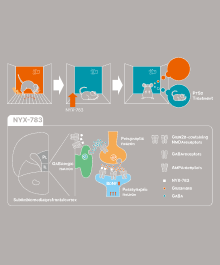
NYX-783, a novel PTSD drug under clinical development, was applied to a PTSD mouse model to study the molecular mechanism of its therapeutic effect. It was found that the drug suppressed fear memory by acting on the NMDA receptors, specifically on the GluN2B subunit protein in excitatory neurons in the sublimbic medial prefrontal cortex. It laid the theoretical foundation for the development of a treatment for PTSD, and at the same time presented a strategy that targets the NMDA protein.
more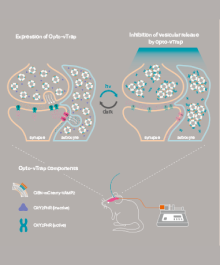
In joint research with KAIST, our Center developed ‘Opto-vTrap’, an optogenetic technology that can freely control brain functions and behaviors using light. Opto-vTrap can freely modulate brain activity by directly controlling the secretion of vesicles. Furthermore, it was confirmed through animal experiments that not only brain cell signal transduction but also memory, emotion, and behavior can be regulated using this approach. As Opto-vTrap can be used on various cells in addition to brain cells, it is expected to contribute to various areas in neuroscience such as mapping of the human brain and epilepsy treatment, as well as muscle spasm and skin muscle expansion technology.
more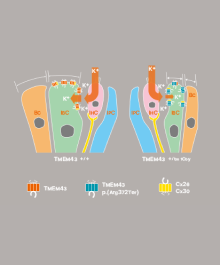
Through joint research with Seoul National University Bundang Hospital, Mokpo University, Central South University of China, and the University of Miami, USA, our Center identified a new deafness gene TMEM43, which is expressed in cochlear support cells, and investigated the mechanism of auditory neuropathy. Prescription of cochlear implant in three deaf patients with defective TMEM43 protein was able to successfully restore their hearing ability. This research is significant in that it has identified the molecular and physiological role of glial cells in the cochlea of the peripheral nervous system, which has been not been studied extensively to date.
more
Through a joint study with the Brain Science Research Institute, our Center revealed for the first time the mechanism of neuronal cell death and induction of dementia caused by reactive astrocytes that occur in the early stages of the disease. The results of this study prove that a severe reactive astrocyte, rather than amyloid beta plaques, is more of a key factor in neuronal apoptosis. Furthermore, it was confirmed that it was possible to suppress the progression of dementia merely by targeting astrocytes to reduce their hydrogen peroxide production.
more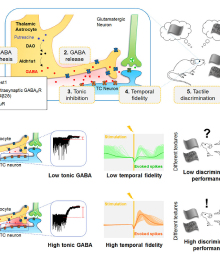
Joint research between our Center and Yonsei University revealed how astrocytes in the brain's thalamus regulate tactile perception through the secretion of GABA. It is expected to lay the foundation for the treatment of sensory disorders by providing an understanding of how the transmission of sensory information is regulated. On the other hand, the study also showed that not only neurons but also astrocytes can play a central role in cognitive function.
more
The exact mechani reaches the amygdala via the central medial thalamic nucleus. These findings are expected to contribute to the treatment of PTSD by explaining how the circuits related to fear memory are regulated and suppressed.
more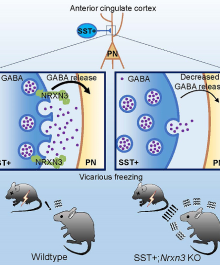
It was discovered that the Nrxn3 gene in the brain is involved in empathy by regulating the synaptic transmission of SST neurons. This is significant in that it uncovered important genes that control empathy in addition to identifying the neural circuit responsible for information processing in the anterior cingulate cortex. These results are expected to contribute to research on the treatment of various psychiatric disorders such as autism, psychopathy, and schizophrenia, all of which manifest in impairment of empathy.
more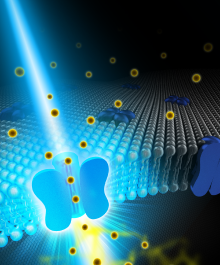
We have developed the world's most efficient 'optical remote control' that can control calcium ion concentrations in living organisms. Application of this technology in the rat brain resulted in successful induction of calcium channel opening, which resulted in a doubling of the rats’ memorization capacity. This is expected to contribute to the treatments for diseases with calcium ion metabolic defects, such as Alzheimer's disease and cardiac arrhythmia.
more